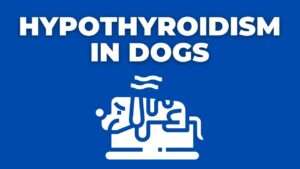Progressive Retinal Atrophy (PRA) is a degenerative eye disorder that affects dogs, leading to gradual vision loss and eventual blindness. Understanding this condition is crucial for dog owners to recognize early symptoms, seek veterinary care, and manage the condition effectively. Let’s delve into a comprehensive guide to PRA in dogs.
Contents Overview
Understanding Progressive Retinal Atrophy (PRA)?
What is Progressive Retinal Atrophy (PRA)?
- Progressive Retinal Atrophy is a genetic disorder that causes the gradual degeneration of the retina, the light-sensitive tissue located at the back of the eye.
- The retina is crucial for vision, as it receives light and converts it into neural signals, which are then sent to the brain, allowing animals to see.
- PRA leads to progressive vision loss, ultimately resulting in blindness.
Types of PRA
- Early-Onset PRA: This type of PRA manifests at a young age, typically before two years old. It progresses rapidly, leading to complete blindness early in life.
- Late-Onset PRA: Late-onset PRA appears later in a dog’s life, usually after two years of age. It progresses more slowly compared to early-onset PRA.
Breeds Affected by PRA
PRA can affect various breeds, including but not limited to:
- Labrador Retriever
- Golden Retriever
- Cocker Spaniel
- Poodle
- Australian Shepherd
- Collie
- Irish Setter
Causes of Progressive Retinal Atrophy (PRA)
- Genetic Mutation:
- PRA is primarily inherited as an autosomal recessive trait, meaning both parents must carry the mutated gene for their offspring to inherit the condition.
- Several genes have been implicated in different forms of PRA in various dog breeds.
- Mutations in genes responsible for the development and function of photoreceptor cells in the retina are often the underlying cause.
- Breed Predisposition:
- Certain dog breeds are more prone to specific forms of PRA due to genetic predisposition.
- Breeds commonly affected by PRA include but are not limited to:
- Labrador Retrievers
- Golden Retrievers
- Cocker Spaniels
- Poodles
- Dachshunds
- Irish Setters
- Hereditary Factors:
- Inherited as a genetic trait, PRA can be passed down from parent dogs to their offspring.
- Dogs carrying one copy of the mutated gene (heterozygous) typically don’t show symptoms but can pass the gene to their offspring.
- Breeding two carriers increases the likelihood of offspring inheriting two copies of the mutated gene (homozygous), resulting in PRA.
- Age of Onset:
- PRA typically manifests in dogs between the ages of 1 to 5 years, although the onset can vary depending on the specific form of PRA and the breed of the dog.
- Some forms of PRA may have a later onset, occurring in dogs older than 5 years.
- Progressive Nature:
- As the name suggests, PRA is progressive, meaning it worsens over time.
- Initially, affected dogs may exhibit symptoms such as night blindness or difficulty seeing in low-light conditions.
- Over time, vision loss progresses, eventually leading to complete blindness.
- Environmental Factors (Rare):
- While the primary cause of PRA is genetic, environmental factors may exacerbate or accelerate the progression of the condition in some cases.
- Exposure to certain toxins, medications, or infections may potentially impact the severity or onset of PRA, although such cases are rare.
Symptoms of Progressive Retinal Atrophy (PRA)
- Night Blindness:
- Dogs with PRA often exhibit difficulty seeing in low-light conditions, particularly at night.
- They may hesitate or become disoriented when navigating dimly lit areas or in darkness.
- Loss of Peripheral Vision:
- As PRA progresses, affected dogs may experience a gradual loss of peripheral vision.
- Owners may notice their pets bumping into objects or displaying reluctance to move in unfamiliar environments.
- Increased Reflectivity in the Eye (Tapetal Hyperreflectivity):
- An early sign of PRA is often an increased shine or reflection from the back of the eye (tapetum).
- This symptom, known as tapetal hyperreflectivity, may be observed during routine eye examinations by a veterinarian.
- Dilated Pupils:
- Dogs with PRA may present with dilated pupils, which do not constrict properly in response to light.
- This abnormality can be detected during a thorough eye examination.
- Progressive Vision Loss:
- Over time, affected dogs experience a progressive decline in vision, eventually leading to blindness.
- Initially, vision loss may be subtle, but it becomes more pronounced as the disease advances.
- Abnormal Eye Behavior:
- Dogs may display unusual eye behaviors such as increased blinking, squinting or rubbing at their eyes.
- These behaviors can indicate discomfort or visual impairment associated with PRA.
- Cataracts and Lens Luxation:
- In some cases of PRA, dogs may develop secondary conditions like cataracts or lens luxation.
- These complications can further compromise vision and necessitate additional medical intervention.
Diagnosing PRA
Diagnosing PRA involves a combination of veterinary evaluation, ophthalmic examination, and specialized testing. Here’s what you need to know about the diagnostic process:
- Veterinary Evaluation: Your veterinarian will begin by conducting a thorough physical examination and obtaining your dog’s medical history. Be sure to provide any information about changes in your dog’s behavior or vision that you’ve observed.
- Ophthalmic Examination: A comprehensive eye examination will be performed to assess the health and function of your dog’s eyes. This may include:
- Visual assessment: Your veterinarian will evaluate your dog’s vision using various tests, such as obstacle courses or tracking moving objects.
- Ophthalmoscopy: This involves examining the interior structures of the eye, including the retina, using a specialized instrument called an ophthalmoscope.
- Tonometry: Measurement of intraocular pressure to assess for conditions like glaucoma, which may accompany PRA in some cases.
- Electroretinography (ERG): ERG is a specialized diagnostic test that measures the electrical responses of the retina to light stimulation. It can help confirm the presence of retinal degeneration and differentiate between different types of PRA.
- Genetic Testing: In many cases, PRA is inherited as an autosomal recessive trait, meaning that dogs must inherit two copies of the mutated gene (one from each parent) to develop the condition. Genetic testing can identify dogs carrying the gene mutation responsible for PRA, allowing breeders to make informed breeding decisions and potentially reducing the prevalence of the disease in future generations.
Treatment and Management:
Treatment Options for PRA
While there is no cure for PRA, several treatment options aim to manage its progression and alleviate symptoms.
Genetic Testing
Identify carriers and affected dogs to prevent passing on the gene.
Helps in breeding programs to reduce the prevalence of PRA in future generations.
Antioxidant Supplements
Antioxidants such as vitamin E and omega-3 fatty acids may slow the progression of retinal degeneration.
Consult your veterinarian for appropriate dosage and administration.
Sildenafil (Viagra)
Studies suggest that sildenafil may improve blood flow to the retina, potentially slowing down retinal degeneration.
It’s essential to use under veterinary supervision due to potential side effects.
Gene Therapy
Experimental treatments involving gene therapy aim to replace defective genes responsible for PRA.
While promising, gene therapy for PRA is still in the early stages of research and may not be widely available yet.
Supportive Care
Provide a safe and familiar environment to help your dog navigate their surroundings.
Use verbal cues and consistent commands to aid in communication.
Management Strategies for Dogs with PRA
In addition to treatment options, implementing management strategies can improve the quality of life for dogs with PRA.
Regular Veterinary Check-ups
Schedule regular eye examinations to monitor the progression of PRA.
Your veterinarian can recommend adjustments to treatment based on the latest developments.
Nutrition and Weight Management
Maintain a balanced diet to support overall health and well-being.
Monitor your dog’s weight to prevent obesity, which can exacerbate health issues, including PRA.
Environmental Modifications
Minimize changes in the environment to help your dog navigate familiar surroundings.
Keep pathways clear of obstacles to prevent accidents.
Behavioral Support
Be patient and understanding as your dog adjusts to vision loss.
Offer reassurance and positive reinforcement to boost their confidence.
Genetic Counseling and Breeding Considerations
Genetic counseling plays a crucial role in managing PRA in breeding programs. It involves assessing the risk of passing on PRA-associated genetic mutations to offspring and making informed breeding decisions to reduce the incidence of the disease.
Key Considerations in Genetic Counseling
- Genetic Testing: Breeders should test their breeding dogs for PRA-associated genetic mutations before breeding. This helps identify carriers and affected individuals.
- Breeding Strategies:
- Avoid Breeding Affected Dogs: Dogs diagnosed with PRA should not be used for breeding to prevent passing on the disease.
- Selective Breeding: Breed carriers only clear dogs to reduce the risk of producing affected offspring.
- Breeding Clear to Clear: Breeding two dogs that have tested clear for PRA-associated mutations ensures offspring will not inherit the disease.
Ethical Considerations
- Breeders have a responsibility to prioritize the health and well-being of dogs. Breeding dogs affected by PRA can lead to unnecessary suffering for future generations.
- Ethical breeding practices involve transparency, honesty, and prioritizing the welfare of the dogs over financial gain.
Bottom Line
Progressive Retinal Atrophy is a progressive and irreversible condition that affects the vision of dogs. While there is no cure, early detection, veterinary care, and proactive management can help improve the quality of life for affected dogs. Responsible breeding practices and genetic testing are essential for reducing the incidence of PRA in susceptible dog breeds. By understanding the causes, symptoms, diagnosis, and management of PRA, dog owners can provide the best possible care for their beloved pets.




































+ There are no comments
Add yours